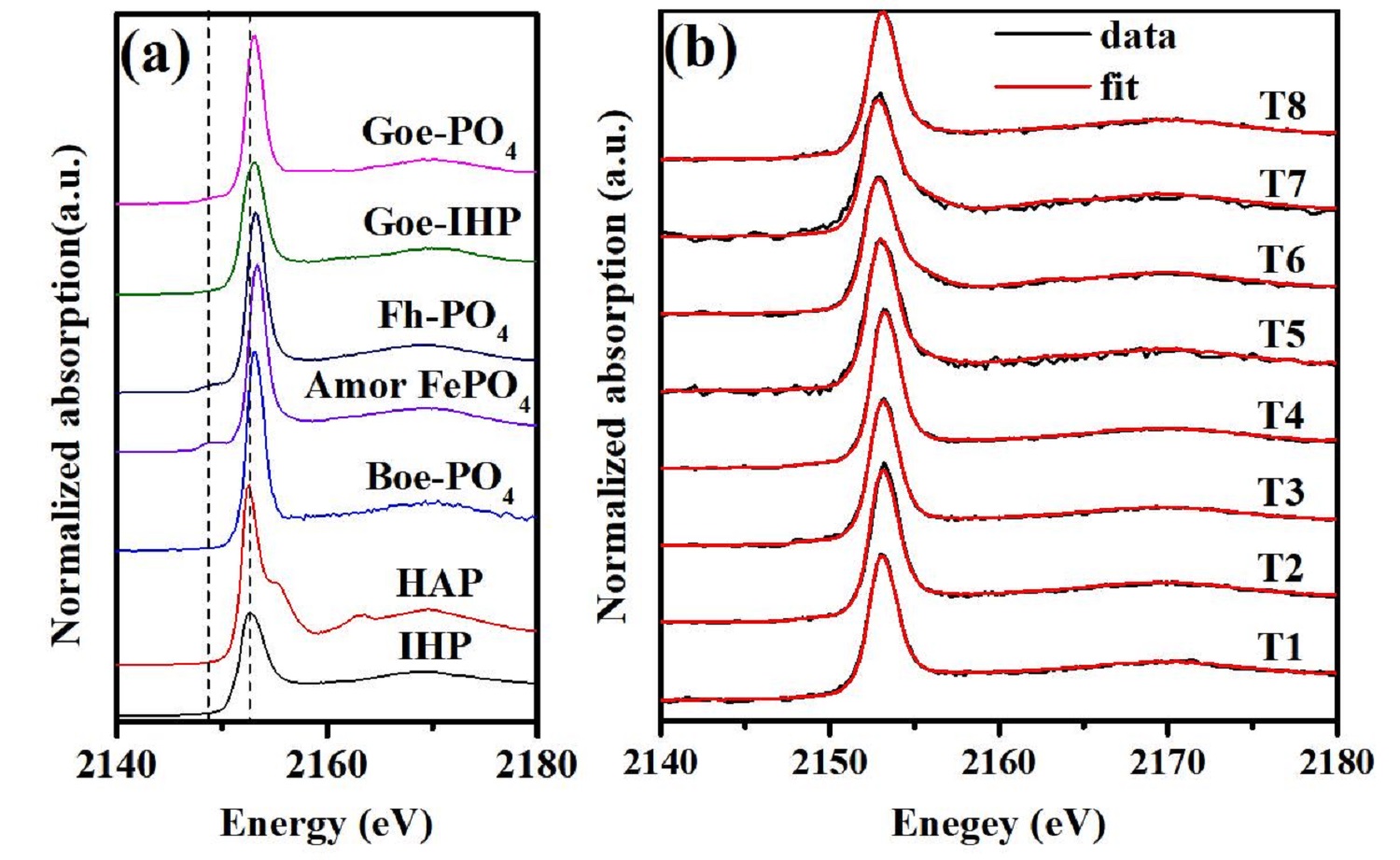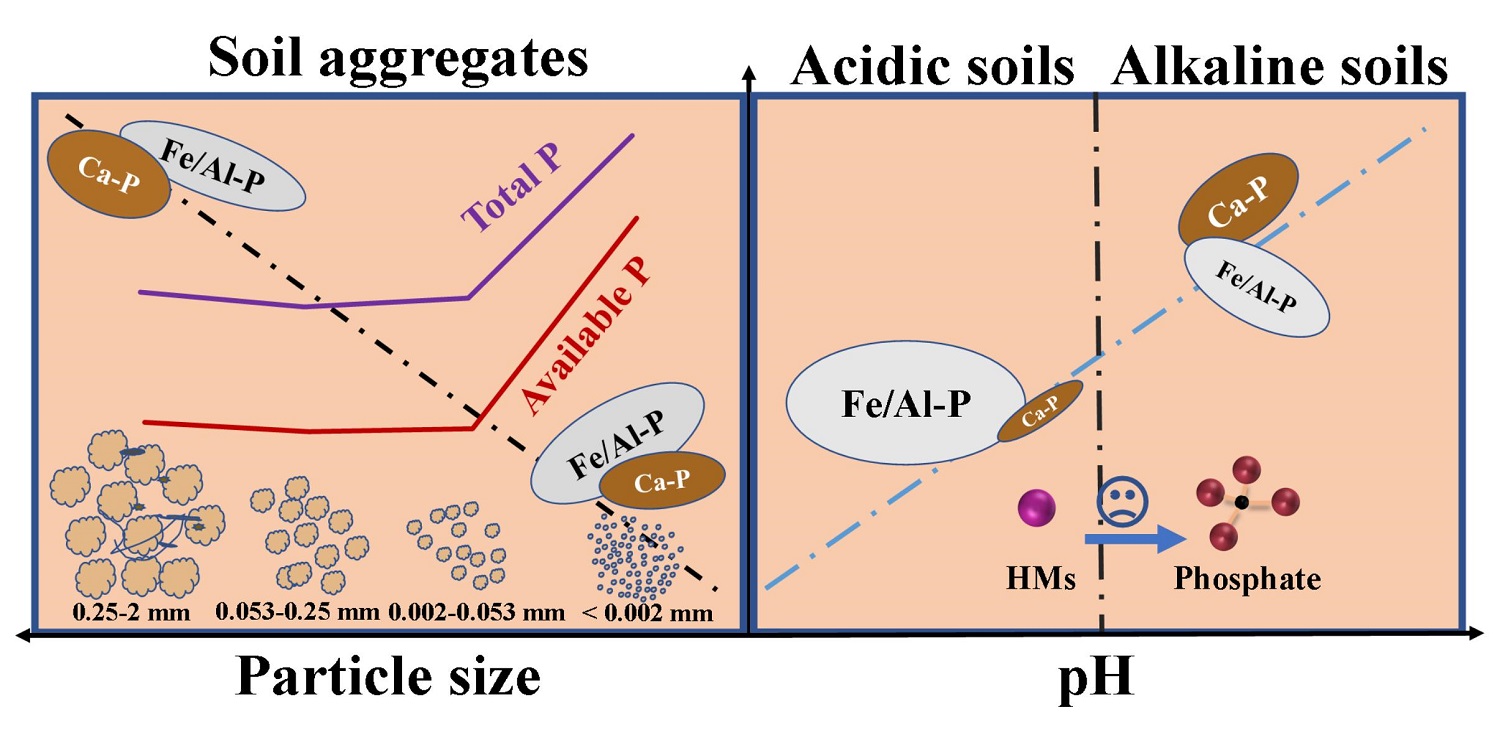南湖新闻网讯(通讯员 赵万通)近日,我校资源与环境学院土壤矿物与环境团队在区域农田土壤磷的化学形态方面取得新进展,相关成果以“Chemical speciation of phosphorus in farmland soils and soil aggregates around mining areas”为题发表于Geoderma期刊。研究通过化学提取、同步辐射光谱和统计分析,系统揭示了不同区域农田土壤和团聚体中磷的化学形态、分布及其与土壤pH、Fe/Al/重金属组分、团聚体粒径等理化特性的关系,为农田土壤磷的高效利用和环境风险评估提供了科学依据。
磷是作物生长必需的营养元素,然而土壤固磷潜力大,大量磷在土壤中盈余,成为土壤累积态磷,无法被作物利用。土壤累积态磷量巨大,是一种潜在磷源,而其中磷赋存形态和分布决定生物有效性、迁移性和环境风险。我国矿区农田土壤面积超过150万公顷,大部分处于耕作状态,且不同区域土壤的理化特性及重金属污染程度不同。但这些土壤中磷的化学形态及与理化特性的关系仍然知之甚少。土壤团聚体粒径也是影响磷形态的重要因子,而相关影响规律尚不明晰。此外,化学提取和P(磷)K边XANES光谱是分析土壤磷形态的两种主要方法,各有优缺点,但少有文献将两种方法进行对比评估。基于此,科研人员采集了我国从南到北几个典型矿区农田土壤样品,结合化学提取、P-K边XANES光谱及相关性分析等,分析了土壤及团聚体样品中磷的化学形态、分布及其与土壤pH、Fe/Al/重金属组分、团聚体粒径等理化特性的内在关联。
结果显示,土壤中游离铁/铝氧化物,特别是无定形铁/铝氧化物是固磷的主要活性组分。其中,无定形铝和铁氧化物中同晶替代铝在磷固定过程中起着非常关键的作用。在酸性土壤和团聚体中,磷以铁磷为主,铝磷次之,钙磷较少;碱性土壤和团聚体中,钙磷比例增加,铁磷比例减少。在这些污染农田土壤中,重金属组分与磷形态表现出一定负相关关系,但未达到显著水平(P > 0.05)。相较于大粒径土壤团聚体,土壤胶体中铁磷占比增加,而钙磷占比减小;由于铁/铝组分在细颗粒中富集,土壤有效磷和全磷均倾向于在胶体中累积。与XANES光谱结果相比,化学提取可能会高估或者低估土壤中钙磷占比,取决于土壤pH;光谱拟合的铁/铝磷占比略高于化学提取结果,有机磷则相反。综上,土壤pH、团聚体粒径和铁/铝组分共同决定了土壤磷的化学形态和分布,调控着磷的迁移性和生物有效性。

图1 标准样品的磷 K 边 XANES 光谱(a)及土壤样品的拟合光谱(b)

图2 土壤及团聚体样品中磷组分随土壤团聚体粒径及pH的变化规律
我校资源与环境学院博士研究生赵万通为论文第一作者,王小明副教授为论文通讯作者。美国怀俄明大学朱孟强副教授、特拉华大学谷春豪博士、江西农业大学严玉鹏博士、华中农业大学冯雄汉教授及硕士生刘哲等参与了部分研究。本研究得到国家自然科学基金(41977021)和国家重点研发计划的资助(2020YFC1806803)。
审核人:王小明
【英文摘要】
Phosphorus (P) speciation determines its bioavailability, mobility, and environmental risk in soils. Farmland soils around mining areas are worldwide distributed, yet the P speciation in such soils remains poorly understood. In this study, we determined the P speciation in the farmland soils and soil aggregates around mining areas from China and evaluated their relationship with soil pH and Fe/Al fractions using chemical extraction, P K-edge X-ray absorption near-edge (XANES) spectroscopy, and correlation analysis. Chemical extraction revealed that soil P was dominated by inorganic P (Pi) (68.0 – 82.5%) largely associated with pedogenic Fe/Al oxides (43.4% – 94.8%). The P was mainly adsorbed and occluded by Fe/Al oxides in acidic soils, while predominantly existed as Ca-P and occluded species in alkaline soils. The presence of heavy metals appeared to have no significant effect on P speciation in these soils. Compared with the macroaggregates, the available P, total P, and their ratio all increased dramatically in the soil colloids (< 0.002 mm) due to the accumulation of Fe/Al oxides. The XANES analysis indicated that the P speciation in the acidic soils and soil aggregates was dominated by Fe-P, followed by Al-P, and little Ca-P; in contrast, the proportions of Ca-P increased but Fe-P decreased in the alkaline soils and soil aggregates. Compared with the macroaggregates, the proportions of Fe-P increased while Ca-P decreased in the soil colloids. Correlation analysis indicated that amorphous Al and isomorphic substitution Al played critical roles in P immobilization by pedogenic Fe/Al oxides. These new insights into the P speciation are essential for environmental risk assessment and efficient utilization of P in the farmland soils.
